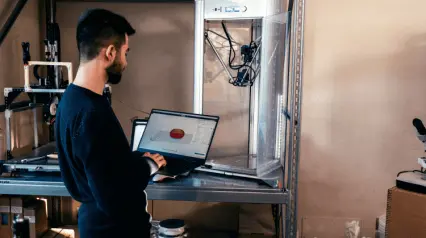What is Additive Manufacturing?
Additive Manufacturing (AM) or Additive Layer Manufacturing (ALM) produces three-dimensional objects from a digital file. It’s also known as 3D printing and involves the successive layering of materials, such as plastics, metals, ceramics, or composites, to create an object. The process starts with a Computer-Aided Design (CAD) file containing instructions for the printer to follow. The printer then builds the object layer by layer until it is complete.
Various industries use additive manufacturing, including aerospace, automotive, medical, and consumer products. It has revolutionized the way products are designed and manufactured, allowing for faster production times and more efficient use of materials. Additionally, using traditional manufacturing methods, AM can create complex geometries that would otherwise be impossible to produce.
Advantages
Creates Complex Geometries
Through this technology; engineers can create parts that would not be possible otherwise. One example would be directly adding complex components to the design, such as conformal cooling channels. Through modern techniques such as 3D printing, many elements that used to require assembly and welding can now be made in one piece, resulting in greater strength and durability. Innovative technology has opened up a range of untapped design options, breaking away from the traditional boundaries of machine-based designs.
Saves Time
Rapid prototyping is possible with additive manufacturing. Plus, 3D CAD files inserted into the machine allow for cost-efficiency and effortless mid-production modifications with little to no disturbance.
Saves Weight
By incorporating organic shapes and patterns into designs, designers can reduce weight without compromising strength and stability.
Additive Manufacturing vs. Conventional Manufacturing
Additive manufacturing is a relatively new technology compared to conventional manufacturing methods. While both processes involve the creation of three-dimensional objects, there are several key differences between them.
Conventional manufacturing typically involves cutting or shaping materials into the desired shape. This process is often time-consuming and requires specialized tools and machinery. Additionally, it can be difficult to produce complex geometries with conventional methods.
On the other hand, additive manufacturing is a much faster process and can easily create complex geometries. Additionally, it requires less material than conventional manufacturing, making it more cost-effective. Furthermore, AM allows for greater customization of products since each layer can be tailored to the customer’s specific needs.
Industries and Applications
Aerospace
By using additive manufacturing, it’s possible to lower costs and production times and decrease the mass of components aboard aeronautical vehicles.
Automotive
Automotive additive manufacturing eliminates the requirement for tools, resulting in lowered development and manufacturing costs. The repeatable process creates components that can be installed directly into serial production vehicles.
Medical
The medical industry often uses 3D printing for personalized implants, models, and guides. Dentists also utilize this technology for creating splints, orthodontic equipment, models, and drill guides. Additionally, researchers have been experimenting with AM to develop artificial tissues and organs.
Industrial Manufacturing
On-demand production of any product is made possible with additive manufacturing, which can reduce the design and launch time. It increases productivity while maintaining a controlled cost structure and fixed lead time.
Avoid Additive Manufacturing Hazards with SafetyCulture
Eliminate manual tasks and streamline your operations.
Get started for FREEDifferent AM Technologies
Electron Beam Melting (EBM) and Direct Metal Laser Melting (DMLM)
With DMLM and EBM processes, materials are melted entirely. A laser melts each layer of powder in the former, while electron beams do the same task in the latter. These methods are suitable for constructing dense, non-permeable objects.
Binder Jet
Binder jetting is a manufacturing technique where a liquid binder attaches thin layers of powder, be it metal, sand, ceramics, or composites, according to a digital design file. This process creates bespoke parts and tools.
Sintering
Sintering is a process used in additive manufacturing that involves the application of heat to a material, such as metal or plastic powder, to create a solid object without liquefying it. This process is similar to 2D photocopying, where heat melts the toner and forms an image on paper.
Laser Sintering
The Direct Metal Laser Sintering (DMLS) process employs a laser to join metal particles and create high-detail objects with desirable surface qualities and the necessary mechanical properties. Similarly, Selective Laser Sintering (SLS) uses a laser’s heat to harden thermoplastic powders, creating strong bonds between particles.
Stereolithography
Stereolithography (SLA) printing utilizes laser-induced photopolymerization to create ceramic objects. The light-curable resin is robust and can endure even the harshest conditions.
Different AM Materials
- Metals – From gold and silver to stainless steel and titanium, additive manufacturing utilizes various metals and metal alloys.
- Ceramics – Zirconia, alumina and tricalcium phosphate can be used in additive manufacturing. Additionally, baking layers of powdered glass and adhesive create unique glass products.
- Thermoplastics – The most popular materials used in additive manufacturing are thermoplastics, such as Acrylonitrile Butadiene Styrene (ABS), Polylactic Acid (PLA), Polycarbonate (PC), and Polyvinyl Alcohol (PVA) (with PVA mainly being support).
- Biochemicals – Biochemical healthcare applications use silicon, calcium phosphate, and zinc to reinforce bones, while research looks into using stem cells to create blood vessels, bladders, and much more.
Various Additive Manufacturing Processes
Powder Bed Fusion
PBF technology, which employs lasers, electron beams, and thermal print heads, is used in various 3D printing processes like Direct Metal Laser Sintering (DMLS), Selective Laser Sintering (SLS), Selective Heat Sintering (SHS), Electron Beam Melting (EBM), and Direct Metal Laser Melting (DMLM). It involves melting or partially melting extremely thin layers of material before finally removing the excess powder surrounding the object.
Binder Jetting
Binder jetting is a 3D printing process that uses an industrial printer to apply a binding liquid onto thin layers of metal, sand, ceramic, or composite particles. It creates custom parts and tooling according to a digital design map, layer by layer, until the object is completed.
Direct Energy Deposition
Direct Energy Deposition (DED) is a process that resembles material extrusion but with a more diverse range of substances such as plastics, ceramics, and metals. It involves using an electron beam gun or laser mounted on a robotic arm to heat wire, filament feedstock, or powder.
Material Extrusion
A widely used additive manufacturing technique, polymers wound on a spool pass through a hot nozzle attached to a movable arm. The mechanism of the arm is such that it can move horizontally while the bed goes up and down, thereby allowing melted material to be built layer by layer. Temperature regulation or chemical bonding agents ensure that every layer correctly adheres to the last one.
Material Jetting
3D printing using material jetting involves a print head that moves along the x, y, and z-axis, similar to an inkjet printer. Cooling or ultraviolet light (UV) curing then hardens the layers.
Sheet Lamination
There are two sheet lamination approaches Laminated Object Manufacturing (LOM) and Ultrasonic Additive Manufacturing (UAM). LOM relies upon alternating layers of paper and adhesive, while UAM fuses thin metal sheets with ultrasonic welding. LOM works well in forming models that are ideal for visuals or aesthetics. UAM is a method that uses little energy and low temperatures, able to be employed on various metals such as titanium, stainless steel, and aluminum.
VAT Polymerization
VAT photopolymerization is a process that allows for the production of objects using liquid resin and UV light, which are then directed with mirrors.
Hazards Related to Additive Manufacturing
The risks posed by additive manufacturing depend on the technology and materials employed. Here are some potential hazards:
- Inhaling powdered materials, solvents, and chemicals released through thermoplastic extrusion or vapor polishing can occur
- Coming into contact with hazardous materials through the skin is possible, mainly in powder or liquid form
- Handling combustible liquids and powders can lead to a fire or explosion hazard
- Activities such as machine maintenance, loading of materials, and product handling, which can potentially cause mechanical or ergonomic strain and injury
- Certain technologies and their environments that may bring different risks
FAQs About Additive Manufacturing
Compared to other manufacturing processes, AM has many advantages. It enables faster and more cost-effective production of prototypes and end-use parts with easier implementation than traditional manufacturing processes, which require a lot of resources and are expensive.
Additive manufacturing utilizes 3D printing as part of a comprehensive industrial production system that entails other activities, such as the printing workflow. It’s distinct from 3D printing, which only encompasses a small portion of the overall process.
Additive manufacturing reduces waste by limiting the material needed, making it a more sustainable form of production. In addition, the use of recycled materials and biodegradable materials can further reduce the environmental impact.
Furthermore, additive manufacturing is more energy efficient than traditional manufacturing methods due to its ability to produce complex parts with fewer steps.
Additive manufacturing is likely to become the primary method of mass production. This new technology, particularly when it comes to polymers, provides a fully automated and digital process that can produce high-quality materials efficiently and economically, enabling it to take over from traditional approaches for high-volume manufacture.




